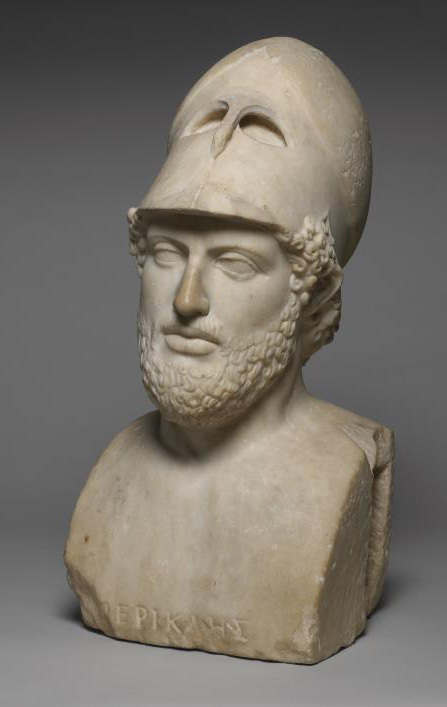Bust of Pericles
Title
Date
Artist or Workshop
Materials
Height of the work
Provenience
Current Location
Description and Significance
Description:
The Roman marble portrait bust, “Bust of Pericles,” depicts the upper chest, neck, and head of a male figure. The figure’s head is slightly tilted to the left, suggesting that the original Greek bronze portrait, the basis for the copy, depicted the full-length of the body in contrapposto posture. Scholars have also proposed that the inclination of the head can be attributed to a personal trait of the figure observed by the original artist. The figure is portrayed without any defect in his facial features, instead shown as an idealized man in the prime of his youth, a common depiction in Classical period portraits of the great men of the polis. The face is represented by the artist as masklike and impassive—lacking any portrayal of human emotion. The expressionless face aligns with the concept of sophrosyne in the Classical period, emphasizing the importance of self-control and composure. The eyes are slightly hooded and stare into the distance with a vacant gaze. The lips are full and slightly parted as though the figure is at the moment before speech. The smooth and unflawed skin of the figure is skillfully sculpted in marble by the unknown Roman copyist. On the crown of his head, the figure wears a Corinthian helmet, a popular style of the Archaic and early Classical periods. He has finely rendered curly hair that fans around the edge of the helmet, and a neatly trimmed beard that frames the elongated face. According to scholars, the nose and parts of the helmet were added in the late-19th or early-20th century after suffering damage. The figure’s name, “ПΕΡΙΚΛHΣ,” is inscribed on the front of the bust in Greek characters from the Late Hellenistic period.
Significance:
Pericles was an Athenian general and statesman active in the late 5th century, valued for his contributions in strategical military pursuits, oratorical skill, and most importantly, his growth of the Athenian Empire. During his lifetime, Pericles hoped to secure Athens’ cultural importance in Greece, notably beginning the reconstruction of the Acropolis after its destruction by the Persians in 480 BC. The Roman copy of the “Bust of Pericles” in the British Museum is one of many excavated at the turn of the 18th century, with three other extant copies housed in the Vatican Museum, the Museo Barracco, and the Berlin Antikensammlung. The placement of the various Roman marble copies is unknown, but the Bust of Pericles would have originally been part of a herm as evidenced by the rectangular spans of the chest and shoulders. Similarly, rectangular "slots" created in the sides of the remaining bust would have held wooden inserts for the hanging of garlands, a feature found in other herms of similar construction. The original Greek bronze portrait with which the copies are based is believed to have been installed on the Acropolis around the period of Pericles’ death in 429 BC. Scholars have suggested that because of his favored view by the Athenians in 439 BC, the time of one of his most successful military campaigns, the dedication from the polis for the bronze portrait would have likely been made for the public Acropolis sanctuary of Athena Polias. Despite his civic successes during the 5th Century, only one defect is described of Pericles by the ancient author Plutarch: his unusually long skull. In the “Bust of Pericles,” and all other representations of Pericles in portraiture, the artist conceals the disproportion of the skull with a Corinthian helmet placed on the crown of the head. Scholars have also suggested that the helmet stands as a symbol for his position as an Athenian general, though Pericles is known more for his actions as a strategist and civilian rather than as a successful military warrior. The idealized representation of Pericles in the Roman copy portrait bust exemplifies his successes for the Athenian people. From the Corinthian helmet on his head suggesting political triumph, to the idealized facial representation of the man who served the polis, the “Bust of Pericles” conveys the importance of celebrating and heroizing the men of action in Greek culture during the Classical period.
References
"Bust of Pericles." The British Museum, www.britishmuseum.org/research/collection_online/collection_object_details.aspx?objectId=461658&partId=1.
Cook, Edward Tyas, compiler. A Popular Handbook to the Greek and Roman Antiquities in the British Museum. London, Macmillan, 1903. 190-191. Print.
Eaton, Daniel Cady. Hand-Book of Greek and Roman Sculpture. 2nd, rev. ed., Boston, James R. Osgood, 1884. 89. Print.
Furtwängler, Adolf, and Heinrich Ludwig Urlichs. Greek and Roman Sculpture. Translated by Horace Taylor, New York, E.P. Dutton, 1914. 208-210. Print.
"Herm-bust of Menander." Museum of Fine Arts Boston, www.mfa.org/collections/object/herm-bust-of-menander-151124.
Lewis, David Malcolm. "Pericles, Athenian Statesman." Encyclopedia Britannica, 9 Aug. 1999, www.britannica.com/biography/Pericles-Athenian-statesman.
Contributor
Citation
Item Relations
This item has no relations.

